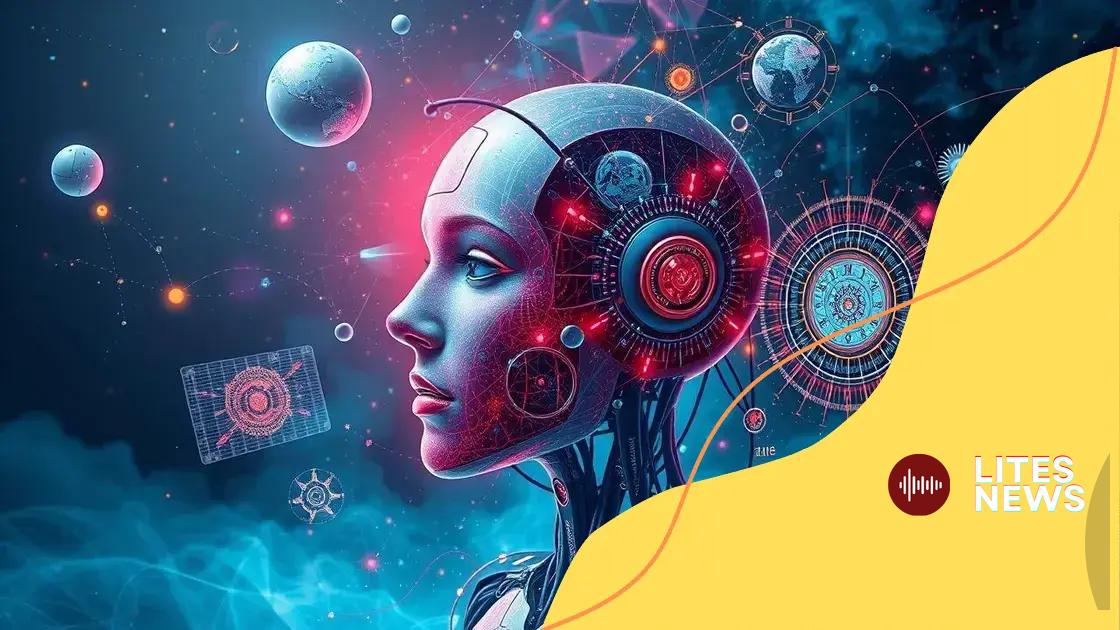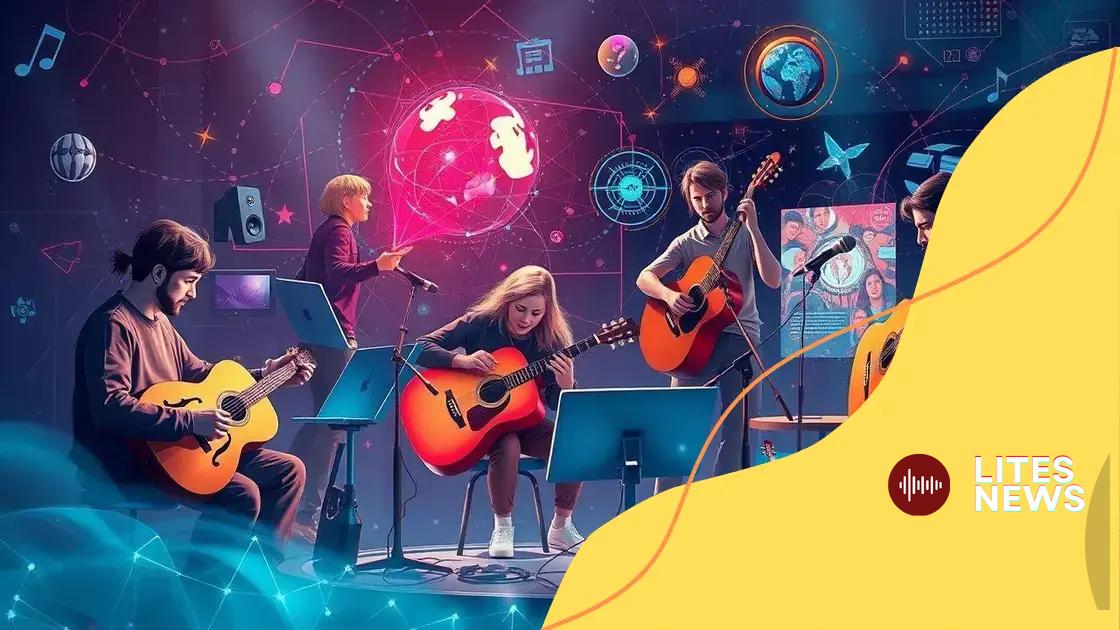The role of AI in transforming the creative industries

The role of AI in transforming the creative industries includes enhancing artistic expression, facilitating collaboration, and enabling personalized creative experiences, while also presenting challenges such as ethical concerns and technical barriers.
The role of AI in transforming the creative industries is becoming increasingly significant. Have you noticed how technology is reshaping creativity? In this article, we’ll delve into AI’s influence on art, music, and design.
Understanding the impact of AI on creativity
Understanding the impact of AI on creativity allows us to see how technology enhances our artistic capabilities. In today’s world, creative professionals are using artificial intelligence tools to push boundaries. Have you ever wondered how something that seems so mechanical can inspire such creativity?
AI as a Collaborative Partner
AI serves as a powerful collaborator for artists, musicians, and writers. Tools powered by AI analyze patterns and trends, offering insights that humans may overlook. This partnership can lead to unexpected creativity and innovation. Many artists now find that AI can generate ideas, provide suggestions, and even assist in the creation process.
Examples of AI-Driven Creative Projects
There are numerous projects demonstrating AI’s creative potential. For instance, AI algorithms can compose music, generate paintings, or even write poetry. Some notable examples include:
- AI-generated artworks that mimic famous styles.
- Music composition platforms that create unique soundtracks.
- Text generators that can produce compelling narratives.
The collaboration between human creativity and AI’s processing power opens up new avenues. As we explore these developments, it’s essential to consider how AI transforms the creative landscape.
The Growing Importance of AI Tools
More creative professionals are adopting AI tools to enhance their work. By leveraging these technologies, they can save time and focus on the aspects of their craft they love most. For instance, writers can use AI to get inspiration for stories, while visual artists can receive suggestions for color palettes or compositions.
A compelling factor in this evolution is the ease of access to powerful AI tools. Today, even amateur creators can experiment with advanced technologies that were once only available to large studios. This democratization of creativity fosters a vibrant environment where anyone can contribute to the arts.
The impact of AI on creativity is profound. As we see this integration, the future of creative industries becomes exciting. The potential for collaboration and innovation continues to grow, leading to a rich tapestry of new forms of expression.
How AI tools enhance artistic expression
How AI tools enhance artistic expression is a fascinating topic. These technologies are not merely tools; they are companions that broaden the limits of human creativity. With the right AI resources, artists can explore new ideas, styles, and techniques.
The Role of AI in Art Creation
AI is increasingly becoming a vital part of the art creation process. Artists can utilize AI systems to generate images, sounds, and even stories. This collaboration results in unique pieces that blend human intuition with machine precision. By using algorithms, artists can experiment with different forms and styles that they might not have considered before.
Benefits of AI in the Creative Process
Using AI tools offers several advantages:
- Inspiration: AI can analyze vast amounts of data to suggest new ideas.
- Efficiency: Artists spend less time on routine tasks and more time on creative thinking.
- Experimentation: AI allows for rapid testing of new concepts without heavy investment.
These benefits help artists push boundaries, encouraging a richer exploration of their creativity.
Case Studies of AI in Art
Many artists have successfully integrated AI into their workflows. For instance, some painters use neural networks to create artworks that evolve based on viewer interaction. Musicians have used AI to produce completely new compositions by analyzing existing music styles. These collaborations have led to exciting innovations in the field.
The process of blending traditional methods with modern technology can lead to compelling results. As we see more artists embracing AI, the landscape of creative expression transforms significantly. Artists are no longer limited to their techniques but can now collaborate with intelligent systems to enhance their work.
Case studies of AI in music and art

Case studies of AI in music and art provide fascinating insights into how these technologies reshape creative fields. Many artists and musicians are increasingly incorporating AI into their work, resulting in groundbreaking projects.
AI in Music Composition
One prominent example is how AI algorithms analyze existing music to create new compositions. For instance, AIVA, an AI composer, generates original pieces by learning from famous works. Musicians are using AIVA’s creations as a foundation to build unique songs, blending human creativity with AI innovation.
AI-Driven Visual Art
In the visual arts, systems like DeepArt use neural networks to transform photographs into paintings that reflect various artistic styles. Artists have embraced these technologies to create stunning pieces that bridge traditional techniques and modern technology. Here are a few highlights:
- AI tools can generate completely new artworks based on prompts, allowing artists to explore unknown styles.
- Collaborative projects between human artists and AI have led to stunning visual displays in galleries worldwide.
- Some artists use AI to identify patterns and trends to inform their work.
The collaboration between AI and artists expands the boundaries of creativity by enabling constant exploration. Another noteworthy project is OpenAI’s Jukebox, which generates music with lyrics in various genres. This advancement showcases the potential of AI to create complex musical pieces that reflect different influences.
These case studies illustrate the dynamic relationship between AI and creativity. Artists are not just users of technology; they are pioneers exploring new frontiers with the help of AI tools. The results of these collaborations redefine what it means to be a creator in today’s world.
Challenges of integrating AI in creative work
Challenges of integrating AI in creative work present important hurdles that artists and creators face. While AI offers numerous benefits, its implementation is not without difficulties. Understanding these obstacles helps navigate the evolving landscape of creativity.
Understanding Resistance to Change
Many artists are resistant to adopting AI tools due to fear of losing their unique touch. Creativity is deeply personal, and some individuals worry that AI may disrupt their individual styles. This fear can lead to hesitation in exploring new tools that can enhance their work.
Ethical Considerations and Intellectual Property
Ethical concerns also play a significant role in the integration of AI. Questions about ownership arise when AI generates art or music. Who owns the copyrights to AI-created content? Furthermore, many creators are concerned about how AI might use their existing work to train algorithms.
Technical Challenges
Integrating AI into the creative process requires technical knowledge that not all artists possess. Many creators may find it daunting to learn how to use AI software effectively. This learning curve can be a barrier to entry, limiting the potential benefits of AI.
Moreover, there is also the risk of over-reliance on AI, which could lead to a decrease in traditional skills. The balance between using AI tools and maintaining one’s artistic abilities is crucial. Artists must find ways to leverage AI without compromising their unique creative voices.
As technology continues to advance, the challenges of integrating AI in creative work will evolve. However, addressing these issues can create a more inclusive and innovative environment for artists.
Future trends of AI in the creative sectors
Future trends of AI in the creative sectors are fascinating to explore. As technology evolves, it continues to reshape how artists, musicians, and writers create. The integration of AI is not just a passing phase; it is transforming the landscape of creativity.
Personalized Artistic Experiences
One emerging trend is the use of AI to create personalized experiences for audiences. For example, algorithms can analyze individual preferences and suggest tailored art or music. This level of personalization can make cultural experiences more engaging and relevant to each viewer or listener.
Enhancing Collaborative Creativity
AI is also set to enhance collaborative creativity among artists. Tools will facilitate seamless integration, allowing creators to work together regardless of location. This collaboration can lead to unique projects that blend various styles and ideas, pushing the boundaries of traditional art forms.
AI as a Creative Assistant
The role of AI as a creative assistant will likely expand, offering artists generating new ideas and helping with technical tasks. This allows creators to focus more on conceptual thinking and less on repetitive tasks. For instance, AI can suggest color palettes, generate variations of a painting, or even compose melodies based on a creator’s style.
Furthermore, as AI becomes more sophisticated, its applications in multimedia storytelling will grow. Artists can leverage AI to create immersive experiences that combine visual art, music, and interactive elements. This trend promises to engage audiences in ways that were previously unimaginable.
As we look to the future, the impact of AI in the creative sectors will continue to evolve. The blending of technology and creativity will open new avenues for artistic expression, making the arts more accessible and diverse.
FAQ – Frequently Asked Questions about AI in the Creative Industries
How is AI changing the way artists create?
AI enables artists to explore new techniques and ideas, enhancing their creativity and allowing for innovative collaborations.
What are some current challenges in using AI in art?
Challenges include resistance to change, ethical concerns regarding ownership, and the technical skills needed to effectively use AI tools.
Can AI enhance collaboration among artists?
Yes, AI tools facilitate collaboration by connecting artists worldwide, enabling them to work together on projects regardless of location.
What future trends in AI should artists be aware of?
Future trends include personalized artistic experiences, AI as a creative assistant, and expanded applications in multimedia storytelling.





